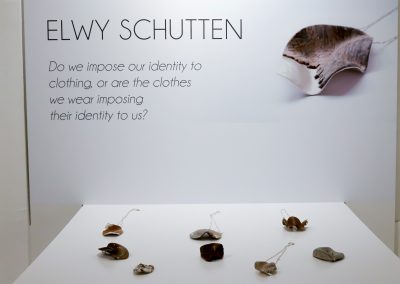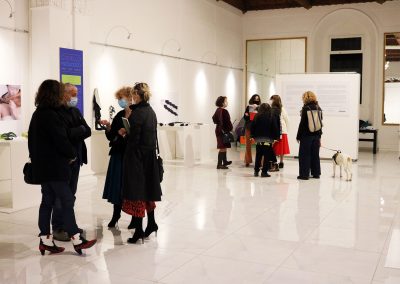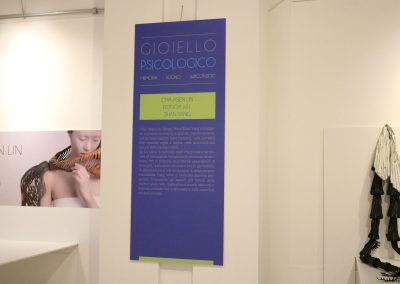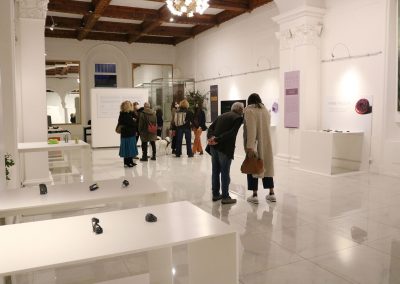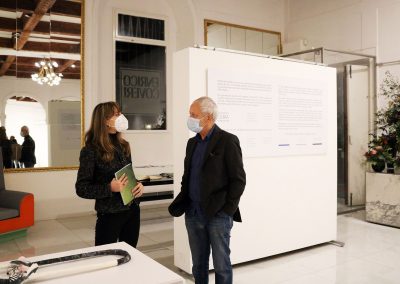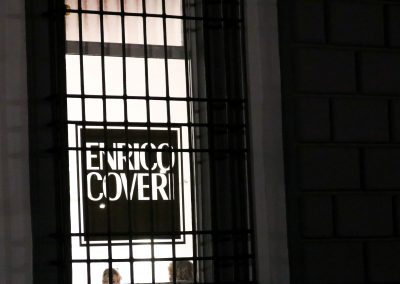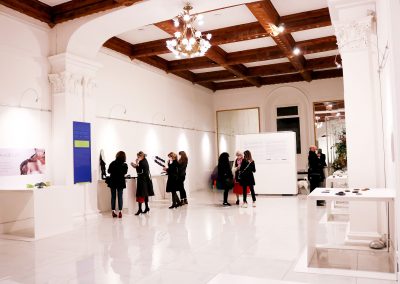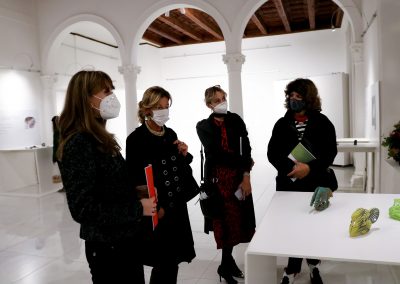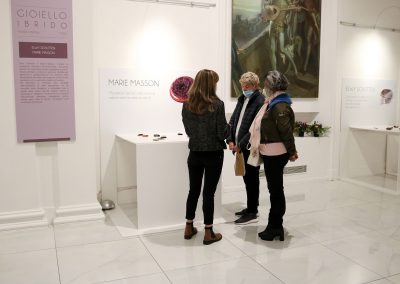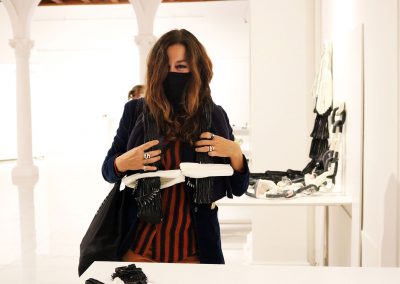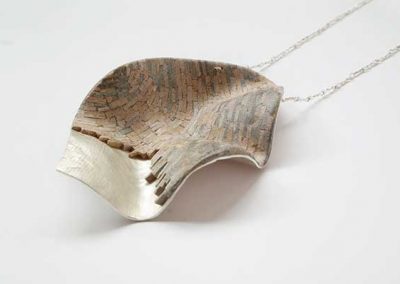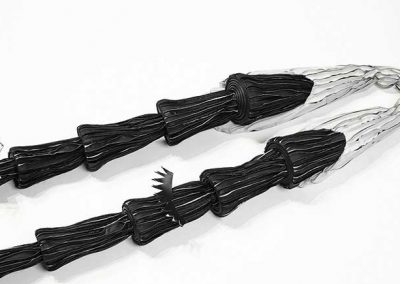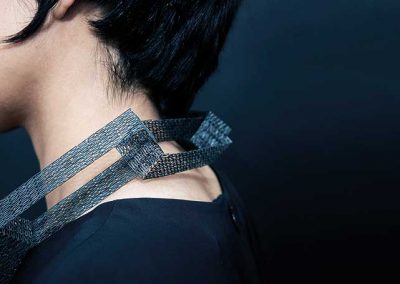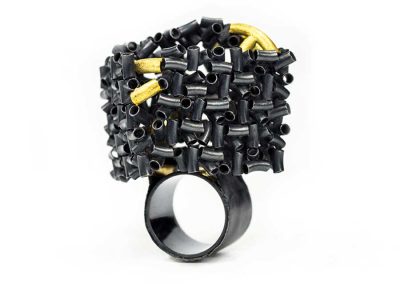
Since 2008, LAO has organized the contest-exhibition“PREZIOSA YOUNG”, dedicated to emerging artists selected through an international competition. The aim is to contribute to the promotion and circulation of what is new in research jewellery. Every edition, we invite worldwide artists, goldsmiths, designers, young professionals to present projects that illustrate the work in which they are currently involved. An international jury composed by curators, artists and critics selects a small number of candidates from all those who have submitted their candidature. The selected artists also have the opportunity to compete for the two special prizes offered by LAO and Inhorgenta Fair.
The LAO prize provides a three-month stay as an “Artist in residence” in Florence, while the Inhorgenta fair will award one of the winners with a free exhibition space for the following year edition of the fair. In the period of residence in Florence, the assignee of the LAO prize commits himself to creating a collection that will be presented on the occasion of the PREZIOSA YOUNG exhibition in Florence.
For the 2020 edition
of the contest,
we received
applications from all over the world.
Please wait while flipbook is loading. For more related info, FAQs and issues please refer to DearFlip WordPress Flipbook Plugin Help documentation.
Chia-Hsien Lin
Chia-Hsien Lin
Smelling Memories
This project was inspired by my own experience of fascination when discovering scents in daily life which directly connect me with past moments from home country. Research explore the strong connection between memories and the sense of smell. My work therefore aims to create sensuous immediacy through the physical and material engagement with the sense of smell, not only touch or vision. The scents in jewellery pieces seek to create direct connections with memories, feelings and experiences. As the interest of preserving scents, I experimented with the materials that can transform liquid into solid, such as plain flour, sweet rice flour, potato starch, and gelatine. I found that the time for gelatine to preserve scent was longer than other materials, therefor decided to use it as the main material in studio practice. According to previous research about the materials, I found out that gelatine is too hard to be formed. In order to solve this issue, I tried to make it softer by adding another ingredient, such as soap base and beeswax. Finally, I decided to use gelatine and soap base as the main materials to make my jewellery pieces and continued the project. This project not only based on my own experience and memories, but also some participant’s personal stories. To gather this qualitative data, firstly I interview four participants to share what they consider to be their most important scent and how it is linked to their past experiences and memories. Secondly, I invited people to smell some model pieces with different scents and interview them to share what they feel or if the scents remind them of some personal memories. This researching process not only gives me the idea of using different colours and shapes to recreate different experiences and feelings on my art pieces, but also provides me a finding that people can evoke their own and unique past experiences and memories by smelling art pieces. About the artworks, main materials are gelatine, soap base, silver-plated brass, and essential oil. The line shape design to let the wind go through easily for releasing scents. All of my jewellery pieces are wearing on different parts of body, like neck, arms, and hands. This collection aims to invite people to evoke or bring their past memories and experience alive through wearing and smelling the jewellery pieces.
Elwy Schutten
Elwy Shutten
Thinking about identity we quickly think of clothing. For example, how you can convey a different message with a t-shirt or blouse. Tell which group you belong to, tell about your origin and your future plans. But what does jewellery add if these messages are already told by clothing? A small hint to something more or something different? If we see a piece of clothing without a human that wears it, without the identity of a person, we can read some values from the piece of clothing. When we wear the piece does our identity merge with the identity of the clothing or does the identity of the clothing reflect on us? Do we impose our identity to clothing, or are the clothes we wear imposing their identity to us? But how does this story come into the clothing? Who decides the identity of the clothing? The maker of the designer? As a carrier, can you then choose from a few identities and switch them on and off according to your own wishes? Like we put on a mask? What remains of our identity when it is so intertwined with our clothing? The pieces are made as small masks questioning the place and the interference of textile and the base of our identity, the skin where identity becomes visible.
Dongyi Wu
Dongyi Wu
Tired
I like to describe myself as a storyteller, and I transfer my own experiences, emotions into my jewelry works by using different types of new and exciting materials. “Tired” series captured a small but interesting moment in my life: When I took my pen and sketchbook to figure out what to do next, I felt very sleepy since that was a tiring afternoon. But I still tried to push myself to concentrate on my sketches. I gradually felt my eyeballs were almost falling off from my eyes, and my eyelashes were also falling. And the pen held by my hands recorded the feeling at that moment. The white neck part made of the reverse side of the gloves represents the eyelid; the pillared shapes built with black fabrics and gloves represent the falling eyeballs. These materials were sewed together after trimmed and cut. The eyelashes made of aluminum cans were cold connected with the main body by sterling silver and rubber cord. “Access to unknown worlds3” describes a dream of mine with a sense of surrealism. The oval shapes bases made by sterling silver were decorated by black and white hand-weaving wax thread, which represent the entrance and exit of the different dream spaces. Animals shuttle among different spaces with surreal and fluid sense. When the pig was entering the black entrance, the zebra’s head came out from the white exit.
Jess Tolbert
Jess Tolbert
Greater Than Series
My current practice explores the use of industrially made products to create jewelry that has the duality of being both manufactured and handcrafted. Certain objects hold utilitarian functions in our everyday lives and serve as a means to an end; however, once they are reimagined as raw material and manipulated by a skilled hand, a transformation takes place. This shift fuses the functional and decorative, as well as memory with imagination. Reconsidering the commonplace objects of everyday life and mass production as jewelry creates an intimate link to our relationship with labor and the built environment. A humble staple is often overlooked, simply used to bind pages together, or to post a flyer to a lamppost; its purpose does not often extend beyond what it was intended for. I am drawn to its recognizable form and to the rhythm of its use. Through repetitive actions of layering, patterning, and systemically constructing, I replicate the pace of mass production, but not its protocols. With infinite possibilities, I reflect upon the unknown makers and their process to create a product that is now my raw material. Capturing labor in the form of jewelry speaks to the associated value typically assigned to such formats. Jewelry is an inherently social form of art, representing wealth, status, and membership, yet also individuality and identity. It is the identity of the maker and wearer that I aim to highlight. With current conversations surrounding manufacturing in the United States and globally, at a moment when many cultures are increasingly face-paced, consumeristic, and accustomed to objects that are disposable, this timely investigation focuses on the merits of reinvention and reclamation as a creative act. It asks us to consider the source, and the role people play in the production of things. In terms of process and materials, I focus on mass-produced products as my raw material. The staple becomes my singular component, one part of a whole. I mirco-weld, or fuse, them together one element at a time. I use the inherent form of the staple to create different patterns, ultimately creating my own ‘sheet’ of material with which I can treat as I would other sheets of metal. I fabricate and hollow construct with this ‘raw material’, creating unique constructions with infinite possibilities. The staples are made of steel and the surface is the result of the fusing process; brooches include the edition of hand-fabricated pin mechanisms in steel and 14K gold.
Marie Masson
Marie Masson
Male coquetry and Cockades | Miniature landscape
Combining the techniques of leatherwork, jewellery and plumasserie, my works revisit the codes of ornementation and are at the edge between art jewellery, decorative arts, sculpture and fashion. I assemble, divert and recontextualize the intimate and natural attributes of the human and animal bodies: hair, leather, feathers and furs are recomposed in the form of pins and objects of great sensuality. My works are hybrid devices inviting the wearer to adopt new postures or gestures but also to question the codes of power, gender and hierarchies usually attached to ornaments. I combine leather works, jewellery and plumasserie to challenge with humor the codes of adornment and especially the issues of gender and power associated with the wearing of jewellery. The series of pins entitled « Male coquetry » and « Cockades | Miniature landscape » are in reference to the cockade. The cockade designates both the military badge worn by the soldiers, the ribbon ornament that adorned some women’s hats but also the ornament of hitching or of the bulls frontal in the context of bullfighting. A way for me to assert the vanishing of any hierarchy between genres – and between human and animal – and to free ornament from its traditional attributes. I focuse on female and male’s wardrobe and draw my inspiration from the utensils and small objects that used to constitute the necessary of the Elegant, highlighting noble and sophisticated materials, whose luxury, without being ostentatious, refers to the objects of curiosity, miniatures, small paintings and precious jewellery pieces (cameos, reliquaries and other hair works …) through art and ornament history.
Rachael Colley
Rachael Colley
Sha-green
Sha-green series presents food waste, in the form of discarded citrus fruit peel, as a sustainable, biodegradable, vegan alternative to the traditionally animal-based luxury decorative surface shagreen (ray or shark skin). This scented material comes alive when worn; as it is warmed by the body it emits a subtle fruity fragrance. The jewellery’s limited lifespan highlights the fleeting and complex nature of human existence and the passing of time, suggesting the ultimate end that conventional jewellery circumvents through its endurance.
Zihan Yang
Zihan Yang
The beauty of being human is not only facing the dark side of this inner world but more importantly how to bravely restrain and lock this darkness in the abyss. My work is driven by personal psychology and a fascination with the subconscious. I focus on personal reflections and definitions of the darkness of human nature by using small repetitive components. My studio practice expresses the complex and dark side of our nature tempered by the beauty of using desires to restrain and balance human desire. The process of making echoes the process of self-examination. We can never fully know ourselves without constant reflection; When we think we must restrain the darkness of human nature, it becomes a kind of desire too, but it seems more positive
con il contributo di Regione Toscana






